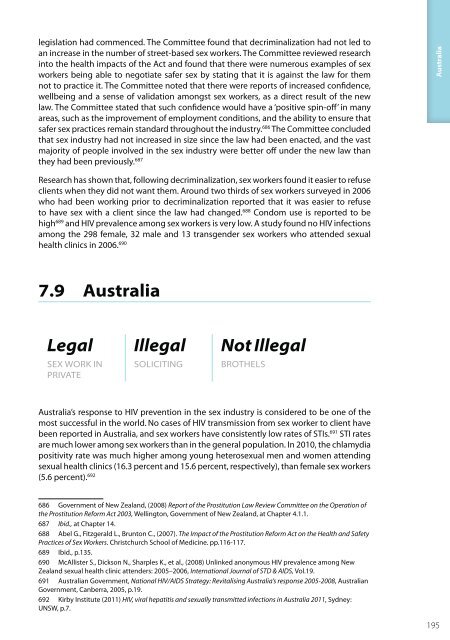SEX WORK AND THE LAW - HIV/AIDS Data Hub
SEX WORK AND THE LAW - HIV/AIDS Data Hub
SEX WORK AND THE LAW - HIV/AIDS Data Hub
Create successful ePaper yourself
Turn your PDF publications into a flip-book with our unique Google optimized e-Paper software.
legislation had commenced. The Committee found that decriminalization had not led to<br />
an increase in the number of street-based sex workers. The Committee reviewed research<br />
into the health impacts of the Act and found that there were numerous examples of sex<br />
workers being able to negotiate safer sex by stating that it is against the law for them<br />
not to practice it. The Committee noted that there were reports of increased confidence,<br />
wellbeing and a sense of validation amongst sex workers, as a direct result of the new<br />
law. The Committee stated that such confidence would have a ‘positive spin-off’ in many<br />
areas, such as the improvement of employment conditions, and the ability to ensure that<br />
safer sex practices remain standard throughout the industry. 686 The Committee concluded<br />
that sex industry had not increased in size since the law had been enacted, and the vast<br />
majority of people involved in the sex industry were better off under the new law than<br />
they had been previously. 687<br />
Australia<br />
Research has shown that, following decriminalization, sex workers found it easier to refuse<br />
clients when they did not want them. Around two thirds of sex workers surveyed in 2006<br />
who had been working prior to decriminalization reported that it was easier to refuse<br />
to have sex with a client since the law had changed. 688 Condom use is reported to be<br />
high 689 and <strong>HIV</strong> prevalence among sex workers is very low. A study found no <strong>HIV</strong> infections<br />
among the 298 female, 32 male and 13 transgender sex workers who attended sexual<br />
health clinics in 2006. 690<br />
7.9 Australia<br />
Legal<br />
<strong>SEX</strong> <strong>WORK</strong> IN<br />
PRIVATE<br />
Illegal<br />
SOLICITING<br />
Not Illegal<br />
BRO<strong>THE</strong>LS<br />
Australia’s response to <strong>HIV</strong> prevention in the sex industry is considered to be one of the<br />
most successful in the world. No cases of <strong>HIV</strong> transmission from sex worker to client have<br />
been reported in Australia, and sex workers have consistently low rates of STIs. 691 STI rates<br />
are much lower among sex workers than in the general population. In 2010, the chlamydia<br />
positivity rate was much higher among young heterosexual men and women attending<br />
sexual health clinics (16.3 percent and 15.6 percent, respectively), than female sex workers<br />
(5.6 percent). 692<br />
686 Government of New Zealand, (2008) Report of the Prostitution Law Review Committee on the Operation of<br />
the Prostitution Reform Act 2003, Wellington, Government of New Zealand, at Chapter 4.1.1.<br />
687 Ibid., at Chapter 14.<br />
688 Abel G., Fitzgerald L., Brunton C., (2007). The Impact of the Prostitution Reform Act on the Health and Safety<br />
Practices of Sex Workers. Christchurch School of Medicine. pp.116-117.<br />
689 Ibid., p.135.<br />
690 McAllister S., Dickson N., Sharples K., et al., (2008) Unlinked anonymous <strong>HIV</strong> prevalence among New<br />
Zealand sexual health clinic attenders: 2005–2006, International Journal of STD & <strong>AIDS</strong>, Vol.19.<br />
691 Australian Government, National <strong>HIV</strong>/<strong>AIDS</strong> Strategy: Revitalising Australia’s response 2005-2008, Australian<br />
Government, Canberra, 2005, p.19.<br />
692 Kirby Institute (2011) <strong>HIV</strong>, viral hepatitis and sexually transmitted infections in Australia 2011, Sydney:<br />
UNSW, p.7.<br />
195
















